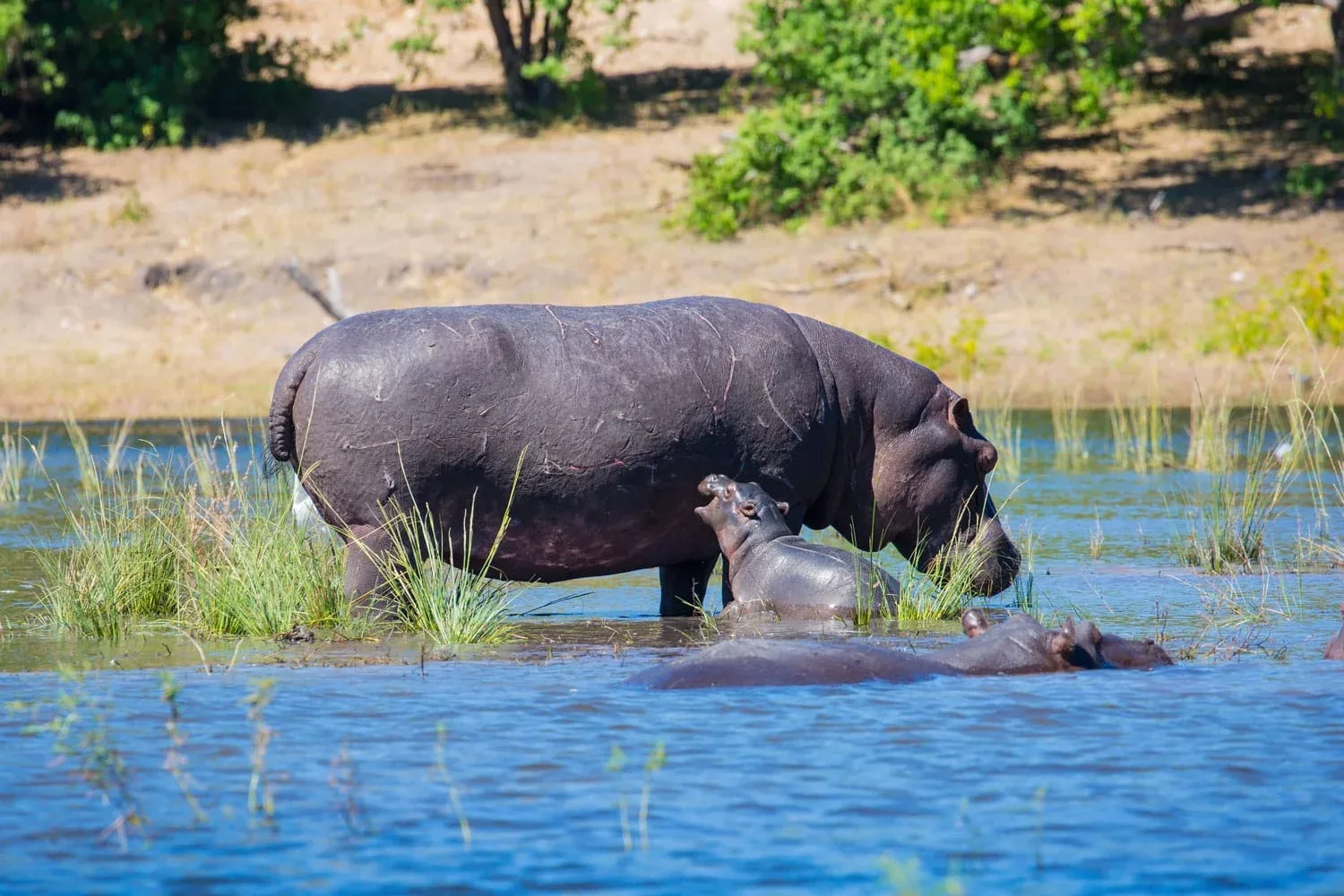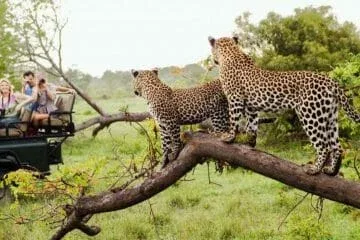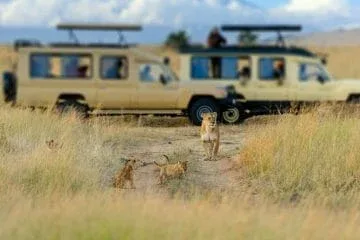
Call Us For Help!
+254 713 380 337
Address
Mombasa Rd., Pacific Crest Mall, 3rd Floor, RM 23
Mail Us
info@exodussafaris.com
- Safaris & tours
TOP DESTINATIONS
- Destinations
- Experiences
- About Us
- Blog
+254 713 380 337
Mombasa Rd., Pacific Crest Mall, 3rd Floor, RM 23
info@exodussafaris.com
Africa gorilla trekking tours offered by Exodussafaris.com provide adventurous travelers with the opportunity to encounter one of the most iconic and endangered species on the planet: the mountain gorilla. Led by experienced guides, these tours take guests into the heart of the African rainforest, where they can witness these majestic creatures in their natural habitat. With destinations including Rwanda, Uganda, and the Democratic Republic of Congo, each tour offers a unique and unforgettable experience, allowing guests to observe gorillas up close and contribute to their conservation.
Exodussafaris.com’s gorilla trekking tours offer a once-in-a-lifetime opportunity to immerse oneself in the breathtaking beauty of Africa’s mountainous landscapes while contributing to the preservation of these critically endangered animals. With options ranging from short treks to multi-day adventures, travelers of all fitness levels can participate in this extraordinary experience. In addition to gorilla encounters, guests can also enjoy cultural interactions with local communities, explore lush rainforests teeming with wildlife, and marvel at the stunning scenery of Africa’s volcanic peaks and verdant valleys.
The primary activity on Africa gorilla trekking tours is, of course, the trek itself. Led by experienced guides, travelers embark on hikes through dense forests in search of habituated gorilla families. The trek can vary in difficulty and duration, but the reward of encountering gorillas in their natural habitat makes it a highlight of the tour. Along the way, trekkers can also learn about the diverse flora and fauna of the region. Additionally, these tours contribute to conservation efforts, helping to protect endangered gorilla populations.
Once gorillas are located, travelers have the incredible opportunity to observe them from a safe and respectful distance. Spending an hour in the presence of these magnificent creatures allows for intimate and unforgettable wildlife encounters. Visitors can observe gorilla behavior, social interactions, and even witness playful antics among the young gorillas. This rare experience provides a deeper understanding of the gorillas’ daily lives and the challenges they face. Moreover, capturing photographs and videos ensures that these memories are cherished for a lifetime.
In addition to gorilla trekking, many tours offer nature walks through the surrounding rainforest. These walks provide opportunities to appreciate the rich biodiversity of the area, with chances to spot other wildlife such as birds, primates, and forest elephants. Guides often share insights into the flora and fauna of the region, enhancing the overall experience. Visitors can also learn about the medicinal properties of various plants found in the forest. Additionally, these walks allow travelers to immerse themselves in the serene and pristine environment of the rainforest.
Gorilla trekking tours often include cultural experiences that allow travelers to engage with local communities living near gorilla habitats. This may involve visits to traditional villages, interactions with indigenous peoples, and opportunities to learn about local customs, traditions, and conservation initiatives. These interactions provide a deeper appreciation of the human aspect of conservation efforts. Additionally, purchasing locally made crafts and products supports the economic well-being of these communities.
Gorilla trekking tours offer incredible opportunities for photography enthusiasts to capture the beauty of the natural surroundings and the unique wildlife encounters. Photographers can capture stunning images of gorillas in their natural habitat, as well as the diverse landscapes and vibrant flora and fauna of the rainforest. Experienced guides often provide tips for capturing the best shots while ensuring minimal disturbance to the gorillas and their habitat. The ever-changing light and dynamic environment make every photograph unique and memorable. Additionally, sharing these images helps raise awareness about gorilla conservation efforts.


January marks the start of the dry season in many gorilla trekking destinations, including Rwanda and Uganda. With less rainfall, trekking conditions are generally favorable, and gorilla sightings are still excellent. It’s a great time to visit with fewer tourists, allowing for a more intimate experience. The dry season also reduces the risk of muddy trails, making the hikes more manageable. Additionally, the clearer weather enhances the overall visibility and enjoyment of the stunning landscapes.
Similar to January, February offers favorable trekking conditions with lower rainfall and fewer tourists. Gorilla families can be found foraging in the forests, providing excellent opportunities for sightings and photography. The pleasant weather makes the treks more enjoyable and less strenuous. Additionally, the lush greenery after the brief rainy season adds to the scenic beauty of the forest.
March sees the transition from the dry season to the rainy season in some gorilla trekking destinations. While there may be occasional rain showers, gorilla trekking is still possible, and the lush green landscapes make for beautiful scenery. It’s advisable to pack rain gear and waterproof clothing. The increased rainfall can enhance the experience by bringing the forest to life with vibrant colors and sounds. Additionally, the rain can make for unique and dramatic photographic opportunities.
April marks the start of the rainy season in many gorilla trekking destinations, bringing heavier rainfall and lush vegetation. While trekking conditions may be more challenging due to muddy trails, gorilla sightings are still possible, and the forests come alive with activity. The rain also means fewer tourists, offering a more exclusive experience. Additionally, the abundant rain supports the flourishing of diverse plant and animal life, enriching the overall trekking experience.
May continues the rainy season, with lush vegetation and abundant wildlife. While trekking conditions may be muddy and slippery, gorilla sightings can still be rewarding. It’s important to come prepared with appropriate clothing and gear for wet weather conditions. The rain can create a mystical atmosphere in the forest, enhancing the sense of adventure. Additionally, the flourishing environment attracts a variety of birds and insects, adding to the biodiversity encountered on the trek.
June marks the start of the dry season in many gorilla trekking destinations, with cooler temperatures and clear skies. Gorilla sightings are excellent during this time, and trekking conditions are optimal. It’s a popular time to visit, so booking in advance is recommended. The dry season also brings out the beauty of the landscape, with clearer views and easier navigation along the trails. Additionally, the comfortable temperatures make for enjoyable hikes and longer wildlife observation sessions.
July is peak season for gorilla trekking, with dry weather and excellent trekking conditions. Gorilla families can be found in the forests, and sightings are almost guaranteed. It’s advisable to book accommodations and permits well in advance due to high demand. The clear skies and sunny days during July also provide ideal lighting conditions for photography, allowing for stunning and memorable shots of the gorillas and their natural habitat. Additionally, the increased activity of wildlife in the dry season adds to the excitement of the trek.
Similar to July, August offers prime gorilla trekking conditions with dry weather and clear skies. It’s a popular time to visit, so travelers should book permits and accommodations early to secure their spot. The dry season also allows for easier access to different parts of the forest, increasing the chances of encountering diverse wildlife and experiencing a variety of landscapes during the trek.
September marks the end of the dry season, with pleasant temperatures and clear skies. Gorilla sightings remain excellent, and trekking conditions are favorable. It’s a great time to visit with fewer tourists compared to peak season months. The transition to the rainy season also brings a refreshing change to the landscape, with new growth and vibrant colors emerging, adding to the overall beauty of the trekking experience.
October sees the start of the short rains in some gorilla trekking destinations, bringing occasional showers. While trekking conditions may be wetter, gorilla sightings are still possible, and the forests are lush and green. The rain showers also create a tranquil ambiance in the forest, with the sound of dripping water and the fresh scent of wet foliage adding to the immersive experience of gorilla trekking.
November continues the short rainy season, with occasional showers and lush vegetation. While trekking conditions may be muddy, gorilla sightings are still excellent, and travelers can enjoy the beauty of the rainforest in bloom. The rain also brings out a variety of flowers and fruits, attracting more wildlife and providing unique opportunities for observing different species during the trek.
December marks the start of the dry season in some gorilla trekking destinations, with clear skies and cooler temperatures. Gorilla sightings are excellent, and trekking conditions are optimal. It’s a great time to visit before the peak tourist season begins. The dry season also offers opportunities to explore other activities in the region, such as birdwatching or cultural experiences, complementing the gorilla trekking adventure.

Birding Safaris in Africa

Big Five Safaris in Africa

The best time to go gorilla trekking in Africa is during the dry season, typically from June to September and December to February. During these months, rainfall is minimal, making trekking conditions more favorable, and gorilla sightings are more predictable.
Gorilla trekking can be physically demanding, as it often involves hiking through dense forests and rugged terrain in search of gorilla families. The duration and difficulty of the trek can vary depending on the location of the gorilla group and the terrain, but most treks last between 1 to 6 hours.
While gorilla trekking, visitors are allowed to get within a few meters of the gorillas. However, strict guidelines are in place to ensure the safety and well-being of both visitors and gorillas. Visitors must maintain a minimum distance of 7 meters from the gorillas to minimize the risk of disease transmission and disturbance.
The number of gorilla permits available per day is limited to regulate the number of visitors and minimize the impact on gorilla populations. In popular destinations like Rwanda and Uganda, a maximum of 8 visitors are allowed to trek with each gorilla group per day.
Essential items to pack for a gorilla trekking tour include sturdy hiking boots, long trousers and long-sleeved shirts, waterproof rain gear, insect repellent, sunscreen, a hat, and a small backpack for carrying essentials. It's also important to bring a camera with extra batteries and memory cards for capturing the experience.
Most gorilla trekking tours have a minimum age requirement of 15 or 16 years old. This is due to the physical demands of the trek and the need for participants to follow safety guidelines and regulations. Additionally, gorilla trekking may not be suitable for individuals with certain medical conditions.
Gorilla trekking tours can be booked through reputable tour operators or directly with national parks and wildlife authorities in gorilla trekking destinations such as Rwanda, Uganda, and the Democratic Republic of Congo. It's advisable to book well in advance, especially during peak season, to secure permits and accommodations.
These tours offer the quintessential gorilla trekking experience, where travelers embark on guided hikes through dense forests to observe mountain gorillas in their natural habitat. The focus is on encountering gorilla families while also enjoying the surrounding landscapes and wildlife. Expert guides provide insights into gorilla behavior, conservation efforts, and the unique ecosystems of the region, enhancing the educational aspect of the trekking experience.
GHE tours allow travelers to participate in the habituation process of gorillas, where researchers and guides work to acclimate wild gorillas to the presence of humans. This immersive experience provides extended time with the gorillas, allowing for more in-depth observation and learning about their behavior. Additionally, participating in the habituation process supports ongoing conservation efforts by fostering positive human-gorilla interactions and promoting long-term coexistence.
Designed for photography enthusiasts, these tours focus on capturing stunning images of gorillas and their habitat. Guides with expertise in wildlife photography provide tips and guidance to help participants capture the best shots while ensuring minimal disturbance to the gorillas. Moreover, these photography-focused tours offer opportunities for participants to engage in post-processing workshops and discussions, enhancing their photography skills and creating lasting memories.
Private gorilla trekking tours offer personalized experiences tailored to the preferences and interests of small groups or individuals. These tours often include exclusive access to gorilla families, luxury accommodations, and customized itineraries. Additionally, private tours may incorporate additional activities such as cultural visits, guided nature walks, or exclusive wildlife encounters, creating a truly immersive and unforgettable journey.
These tours combine gorilla trekking with opportunities to learn about conservation efforts aimed at protecting gorillas and their habitats. Travelers may visit research centers, engage with local communities, and participate in conservation activities such as tree planting or wildlife monitoring. Additionally, these experiences foster a deeper understanding of the interconnectedness between wildlife conservation, sustainable tourism, and local livelihoods, promoting responsible travel practices.
Africa gorilla trekking tours offer travelers an unparalleled opportunity to venture into the heart of the continent’s dense rainforests in search of one of its most iconic and endangered species: the mountain gorilla. Guided by experienced trackers and armed with permits, adventurers embark on exhilarating hikes through rugged terrain, immersing themselves in the lush landscapes of countries like Rwanda, Uganda, and the Democratic Republic of Congo. These tours not only provide an up-close encounter with gorillas but also contribute to their conservation, ensuring the survival of these magnificent creatures for future generations. Additionally, the immersive nature of these tours fosters a deep appreciation for the importance of protecting natural habitats and preserving biodiversity across Africa’s diverse ecosystems.
Gorilla trekking tours typically take place in protected areas such as Volcanoes National Park in Rwanda, Bwindi Impenetrable National Park in Uganda, and Virunga National Park in the Democratic Republic of Congo. These biodiverse habitats are home to thriving populations of mountain gorillas, offering visitors the chance to witness these majestic creatures in their natural environment. Moreover, the presence of gorilla trekking tours in these protected areas helps promote conservation awareness and sustainable tourism practices, ensuring the long-term preservation of gorilla populations and their habitats.
Gorilla trekking tours play a crucial role in gorilla conservation efforts, as the revenue generated from permits contributes directly to habitat protection, anti-poaching measures, and community development projects in gorilla habitats. By participating in these tours, travelers not only fulfill a lifelong dream of encountering gorillas but also support ongoing conservation initiatives that are vital for the survival of the species. Additionally, the positive economic impact of gorilla tourism helps incentivize local communities to engage in sustainable practices and conservation partnerships, fostering long-term conservation success.
Gorilla trekking involves hiking through dense forests, navigating steep slopes, and crossing streams, making it a physically demanding but incredibly rewarding experience. Experienced guides lead small groups of travelers, tracking gorilla families and providing insights into their behavior, habitat, and conservation status along the way. Additionally, the sense of accomplishment after successfully completing a gorilla trek and encountering these majestic creatures in their natural habitat is unparalleled, making it a bucket-list-worthy adventure for many wildlife enthusiasts.
The highlight of gorilla trekking tours is undoubtedly the opportunity to encounter gorillas in the wild. Visitors may spend an hour observing these gentle giants as they go about their daily activities, including feeding, playing, and caring for their young. These intimate wildlife encounters create lasting memories and foster a deeper appreciation for gorilla conservation. Additionally, witnessing the complex social dynamics within gorilla families provides valuable insights into their behavior and the importance of preserving their natural habitats.
Gorilla trekking tours often include interactions with local communities living near gorilla habitats, providing travelers with insights into their traditional lifestyles, customs, and conservation practices. This cultural exchange enhances the overall travel experience and fosters a deeper connection to the land and its people. Additionally, these interactions promote sustainable tourism by supporting local economies and encouraging cultural preservation.
Responsible tourism practices are paramount on gorilla trekking tours to minimize the impact on gorillas and their habitats. Strict guidelines, such as maintaining a safe distance from gorillas, limiting the number of visitors per trekking group, and minimizing noise and disturbance, ensure the well-being of gorillas and their natural environment. By adhering to these principles, travelers can enjoy meaningful and sustainable gorilla encounters while preserving Africa’s precious wildlife heritage. Furthermore, supporting local conservation initiatives and community-based tourism projects contributes to the long-term protection of gorillas and their ecosystems.